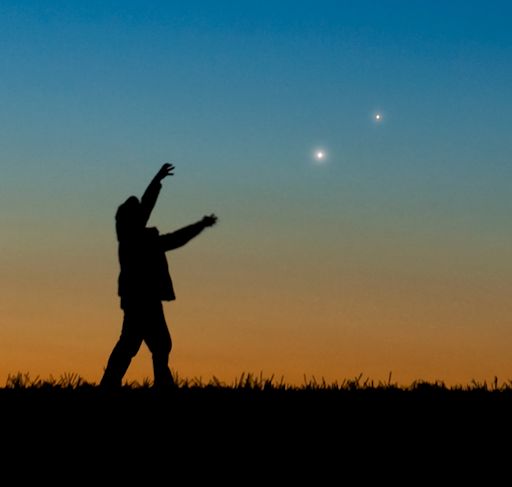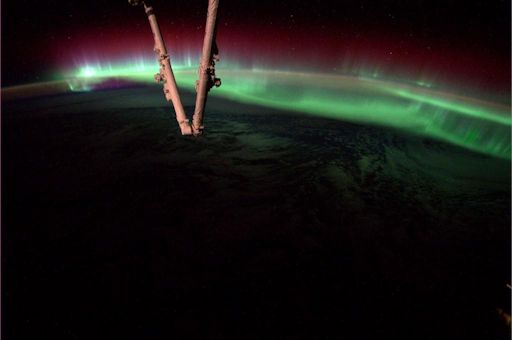Daily Suspicious0bserver's Weather Post:
August 19, 2014
What's in the sky tonight?
August 19, 2014
-If you're in the Earth's mid-northern latitudes, bright Vega passes close by your zenith just as night becomes fully dark. Whenever you see Vega at its closest to straight up, you know that Sagittarius, with its deep-sky riches, is at its highest in the south.
-A minor CME hit Earth's magnetic field on August 19th at approximately 06:30 UT. The impact was not a strong one. Nevertheless, mild to moderate geomagnetic storms are possible at high latitudes as Earth moves through the CME's wake on August 19-20.
-Set your alarm for dawn. Venus and Jupiter are putting on a fantastic show in the early morning sky. At daybreak on Tuesday, August 19, Marek Nikodem caught the planets rising over Szubin, Poland:
"It was a beautiful celestial dawn," says Nikodem, "definitely worth waking up for."
Following their 0.2o near-miss on Monday, August 18th, Venus and Jupiter are separating, but not too quickly. They'll remain in the same patch of sunrise sky for the rest of the week. A date of special interest is August 23rd when the crescent Moon joins the planets to form a must-see celestial triangle.
 Astro Picture of the Day:
August 19, 2014
Source:
Astro Picture of the Day:
August 19, 2014
Source:
Where should Philae land? As ESA's robotic spacecraft Rosetta circles toward Comet 67P/ Churyumov-Gerasimenko, a decision must eventually be made as to where its mechanical lander should attempt to touch-down. Reaching the comet earlier this month, Rosetta is sending back detailed pictures of the comet's unusual nucleus from which a smooth landing site will be selected. Pictured above, near the image top, the head of the comet's nucleus shows rugged grooves, while near the image bottom, the body shows a patch-work of areas sometimes separated by jagged hills. Some of the patch-work areas apparent on both the head and body seem to have fields of relatively smooth terrain. In the connecting area called the neck, however, visible across the image center, a relatively large swath of light-colored smooth terrain appears, punctuated occasionally by large boulders. Rosetta is scheduled to release Philae toward the dark mountain-sized comet nucleus with an anticipated landing date in November.
Daily Suspicious0bserver's Weather Post:
August 20, 2014
What's in the sky tonight?
August 20, 2014
-A moderate (G2-class) geomagnetic storm that erupted following a CME strike on August 19th is subsiding now. At its peak, the storm sparked auroras around both poles visible from the ground and from space. Astronaut Reid Wiseman took this picture from the window of the International Space Station:
"Never in my wildest dreams did I imagine this," tweeted Wiseman (@astro_reid). "Unbelievable."
Around the Arctic Circle where the midnight sun has overwhelmed auroras since Spring, observers caught their first glimpse of Northern Lights in months "At one point a massive corona unfolded just over my head!" reports Alexander Kuznetsov from the Finnish Lapland. "It was a great season opener," added Pekka Hyytinen of Tampere, Finland. "I also caught a lightning strike in one of my photos."
Solar wind conditions are unsettled but calming as Earth passes through the wake of the CME. NOAA forecasters estimate a waning 30% to 15% chance of more geomagnetic storms during the next 24 hours.

 Astro Picture of the Day:
August 20, 2014
Source:
Astro Picture of the Day:
August 20, 2014
Source:
The center of the Lagoon Nebula is a whirlwind of spectacular star formation. Visible near the image center, at least two long funnel-shaped clouds, each roughly half a light-year long, have been formed by extreme stellar winds and intense energetic starlight. The tremendously bright nearby star, Hershel 36, lights the area. Walls of dust hide and redden other hot young stars. As energy from these stars pours into the cool dust and gas, large temperature differences in adjoining regions can be created generating shearing winds which may cause the funnels. This picture, spanning about 5 light years, combines images taken by the orbiting Hubble Space Telescope. The Lagoon Nebula, also known as M8, lies about 5,000 light years distant toward the constellation of Sagittarius.